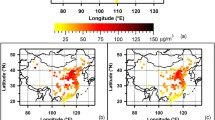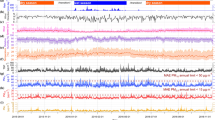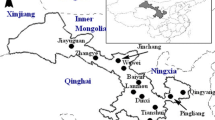Abstract
Air pollution has become a top environmental concern in China. In the present study, 9 years of PM10 and PM2.5 data from an urban monitoring station in Beijing was analyzed relative to other gaseous pollutants and several meteorological parameters. The levels and characteristics of particulate matters as well as the sources and factors affecting them were provided in the present study. During the 9-year observation period, PM10 and PM2.5 showed high levels, with annual mean values of 138.5 ± 92.9 and 72.3 ± 54.4 μg/m3, respectively. Slight decreasing trends of annual mean PM10 and PM2.5 were observed; autumn was the main season that contributed to the decrease in annual mean PM10 and PM2.5. Higher values for both PM fractions were generally observed in the spring and summer months, respectively, whereas lower values were found in the summer and spring months, respectively. Pronounced diurnal variations were found for PM10 and PM2.5, which both displayed a bimodal pattern with peaks between 7:00 and 8:00 a.m. as well as 7:00 and 11:00 p.m.; a minimum generally appeared at approximately noon. The seasonal and diurnal variations in particulate concentration are mostly dominated by the seasonal and diurnal variability of boundary layer and source emissions. A principal components analysis revealed that both the traffic-related emissions and combustion sources were major contributions to the particles; their contributions ranged between 35.5–75.1 %. Furthermore, a directional analysis shows a stronger association between particles and the southerly winds, the PM derived from sources south of Beijing, most likely secondary PM, significantly affects concentrations at the sampling site. To improve air quality in Beijing, mitigation measures including phasing out high energy-consuming industries and prioritize the use of clean energy sources should be designed to reduce emissions from both local and regional sources.








Similar content being viewed by others
References
Anttila P, Tuovinen JP (2010) Trends of primary and secondary pollutant concentrations in Finland in 1994–2007. Atmos Environ 44:30–41
Artínano B, Salvador P, Alonso DG, Querol X, Alastuey A (2003) Anthropogenic and natural influence on the PM10 and PM2.5 aerosol in Madrid (Spain). Analysis of high concentration episodes. Environ Pollut 125:453–465
Barmpadimos I, Hueglin C, Keller J, Henne S, Prévôt ASH (2011) Influence of meteorology on PM10 trends and variability in Switzerland from 1991 to 2008. Atmos Chem Phys 11:1813–1835
Beijing Environmental Protection Bureau (2004) Report on the State of the Environment in Beijing in 2002. www.bjepb.gov.cn/bjhb/tabid/68/InfoID/2618/Default.aspx.
Beijing Environmental Protection Bureau (2005) Report on the State of the Environment in Beijing in 2004. www.bjepb.gov.cn/bjhb/tabid/68/InfoID/2620/Default.aspx.
Bell ML, Dominici F, Ebisu K, Zeger SL, Same JM (2007) Spatial and temporal variation in PM2.5 chemical composition in the United States for health effects studies. Environ Health Perspect 115:989–995
Carslaw D, Ropkins K (2011) OpenAir: open-source tools for the analysis of air pollution data. http://www.openair-project.org/.
Chaloulakou A, Kassomenos P, Spyrellis N, Demokritou P, Koutrakis P (2003) Measurements of PM10 and PM2.5 particle concentrations in Athens, Greece. Atmos Environ 37:649–660
Chaloulakou A, Kassomenos P, Grivas G, Spyrellis N (2005) Particulate matter and black smoke concentration levels in central Athens, Greece. Environ Int 31:651–659
Chan CK, Yao XH (2008) Air pollution in mega cities in China. Atmos Environ 42:1–42
Chan CY, Xu XD, Li YS, Wong KH, Ding GA, Chan LY, Cheng XH (2005) Characteristics of vertical profiles and sources of PM2.5, PM10 and carbonaceous species in Beijing. Atmos Environ 39:5113–5124
Chen D, Cheng S, Liu L, Chen T, Guo X (2007) An integrated MM5-CMAQ modeling approach for assessing trans-boundary PM10 contribution to the host city of 2008 Olympic summer games-Beijing, China. Atmos Environ 41:1237–1250
Dan M, Zhuang G, Li X, Tao H, Zhuang Y (2004) The characteristics of carbonaceous species and their sources in PM2.5 in Beijing. Atmos Environ 38:3443–3452
Darlington TL, Kahlbaum DF, Heuss JM, Wolf GT (1997) Analysis of PM10 trends in the United States from 1988 through 1995, JAPCA. J Air Waste Manage Assoc 47:1070–1078
DeGaetano AT, Doherty OM (2004) Temporal, spatial and meteorological variations in hourly PM2.5 concentration extremes in New York City. Atmos Environ 38:1547–1558
Dobrzhinsky N, Krugly E, Kliucininkas L, Prasauskas T, Kireitseu M, Zerrath A, Martuzevicius D (2012) Characterization of desert road dust aerosol from provinces of Afghanistan and Iraq. Aerosol Air Qual Res 12:1209–1216
Dockery DWC, Pope A, Xu X, Spengler JD, Ware JH, Fay ME, Ferris BG, Speizer FE (1993) An association between air pollution and mortality in six US cities. New Engl J Med 329:1753–1759
Duan FK, He KB, Ma YL, Yang FM, Yu XC, Cadle SH, Chan T, Mulawa PA (2006) Concentration and chemical characteristics of PM2.5 in Beijing, China: 2001–2002. Sci Total Environ 355:264–275
Engler C, Birmili W, Spindler G, Wiedensohler A (2012) Analysis of exceedances in the daily PM10 mass concentration (50 μg m−3) at a roadside station in Leipzig, Germany. Atmos Chem Phys 12:10107–10123
Gehrig R, Buchmann B (2003) Characterising seasonal variations and spatial distribution of ambient PM10 and PM2.5 concentrations based on long-term Swiss monitoring data. Atmos Environ 37:2571–2580
Gomišček B, Hauck H, Stopper S, Preining O (2004) Spatial and temporal variations of PM1, PM2.5, PM10 and particle number concentration during the AUPHEP-project. Atmos Environ 38:3917–3934
Grivas G, Chaloulakou A, Samara C, Spyrellis N (2004) Spatial and temporal variation of PM10 mass concentrations within the Greater Area of Athens, Greece. Water Air Soil Pollut 158:357–371
Grivas G, Chaloulakou A, Kassomenos P (2008) An overview of the PM10 pollution problem, in the Metropolitan Area of Athens, Greece. Assessment of controlling factors and potential impact of long range transport. Sci Total Environ 389:165–177
Guinot B, Roger J, Cachier H, Wang P, Bai J, Yu T (2006) Impact of vertical atmospheric structure on Beijing aerosol distribution. Atmos Environ 40:5167–5180
Guinot B, Hélène C, Jean S, Yu T, Wang X, Yu JH (2007) Beijing aerosol: atmospheric interactions and new trends. J Geophys Res 112, D14314. doi:10.1029/2006JD008195
Guo Z, Sheng L, Feng J, Fang M (2003) Seasonal variation of solvent extractable organic compounds in the aerosols in Qingdao, China. Atmos Environ 37:1825–1834
Guo S, Hu M, Wang ZB, Slanina J, Zhao YL (2010) Size-resolved aerosol water-soluble ionic compositions in the summer of Beijing: implication of regional secondary formation. Atmos Chem Phys 10:947–959
Harrison RM, Deacon AR, Jones MR (1997) Sources and processes affecting concentrations of PM10 and PM2.5 particulate matter in Birmingham (U.K.). Atmos Environ 31:4105–4117
Hauck H, Berner A, Frischer T, Gomiscek B, Kundi M, Neuberger M, Puxbaum H, Preining O (2004) AUPHEP‒Austrian project on health effects of particulates—general overview. Atmos Environ 38:3905–3915
He KB, Yang FM, Ma Y, Zhang Q, Yao X, Chan CK, Cadle S, Chan T, Mulawa P (2001) The characteristics of PM2.5 in Beijing, China. Atmos Environ 35:4959–4970
Huang XF, He LY, Hu M, Zhang YH (2006) Annual variation of particulate organic compounds in PM2.5 in the urban atmosphere of Beijing. Atmos Environ 40:2449–2458
Hueglin C, Gehrig R, Baltensperger U, Gysel M, Monn C, Vonmont H (2005) Chemical characterisation of PM2.5, PM10 and coarse particles at urban, near-city and rural sites in Switzerland. Atmos Environ 39:637–651
Jia YT, Rahn KA, He KB, Wen TX, Wang YS (2008) A novel technique for quantifying the regional component of urban aerosol solely from its sawtooth cycles. J Geophys Res 113, D21309. doi:10.1029/2008JD010389
Kassomenos PA, Vardoulakis S, Chaloulakou A, Paschalidou AK, Grivas G, Borge R, Lumbreras J (2014) Study of PM10 and PM2.5 levels in three European cities: analysis of intra and inter urban variations. Atmos Environ 87:153–163
Kim B, Teffera MS, Zeldin MD (2000) Characterization of PM2.5 and PM10 in the South Coast Air Basin of Southern California: part 1—spatial variations. J Air Waste Manage Assoc 50:2034–2044
Laakso L, Hussein T, Aarnio P, Komppula M, Hiltunen V, Viisanen Y, Kulmala M (2003) Diurnal and annual characteristics of particle mass and number concentrations in urban, rural and Arctic environments in Finland. Atmos Environ 37:2629–2641
Li JJ, Wang GH, Wang XM, Cao JJ, Sun T, Cheng CL, Meng JJ, Hu TF, Liu SX (2013) Abundance, composition and source of atmospheric PM2.5 at a remote site in the Tibetan Plateau, China. Tellus B 65:20281. doi:10.3402/tellusb.v65i0.20281
Liu Q, Sun Y, Hu B, Liu ZR, Akio S, Wang YS (2012) In situ measurement of PM1 organic aerosol in Beijing winter using a high-resolution aerosol mass spectrometer. Chinese Sci Bull 57:819–826
Liu YJ, Zhang TT, Liu QY, Zhang RJ, Sun ZQ, Zhang MG (2014) Seasonal variation of physical and chemical properties in TSP, PM10 and PM2.5 at a roadside site in Beijing and their influence on atmospheric visibility. Aerosol Air Qual Res 14:954–969
Marcazzan GM, Vaccaro S, Valli G, Vecchi R (2001) Characterization of PM10 and PM2.5 particulate matter in the ambient air of Milan (Italy). Atmos Environ 35:4639–4650
Meng ZY, Xu XB, Wang T, Zhang XY, Yu XL, Wang SF, Lin WL, Chen YZ, Jiang YA, An XQ (2010) Ambient sulfur dioxide, nitrogen dioxide, and ammonia at ten background and rural sites in China during 2007–2008. Atmos Environ 44:2625–2631
Miao S, Chen F, LeMone M, Tewari M, Li Q, Wang Y (2008) An observational and modeling study of characteristics of Urban Heat Island and boundary layer structures in Beijing. J Appl Meteorol Climatol 48:484–501
Nel A (2005) Air pollution-related illness: effects of particles. Science 308:804–806. doi:10.1126/science.1108752
Pateraki S, Maggos T, Michopoulos J, Flocas HA, Asimakopoulos DN, Vasilakos C (2008) Ions species size distribution in particulate matter associated with VOCs and meteorological conditions over an urban region. Chemosphere 72:496–503
Pateraki S, Asimakopoulos DN, Maggos T, Vasilakos C (2010) Particulate matter levels in a suburban Mediterranean area: analysis of a 53-month long experimental campaign. J Hazard Mater 182:801–811
Pope CA III, Dockery DW (2006) Health effects of fine particulate air pollution: lines that connect. J Air Waste Manag Assoc 56:709–742
Querol X, Alastuey A, Moreno T, Viana MM, Castillo S, Pey J, Rodrıguez S, Artinano B, Salvador P, Sanchez M, Garcia Dos Santos S, Herce Garraleta MD, Fernandez-Patier R, Moreno-Grau S, Negral L, Minguillon MC, Monfort E, Sanz MJ, Palomo-Marın R, Pinilla-Gil E, Cuevas E, de la Rosa J, Sanchez de la Campa A (2008) Spatial and temporal variations in airborne particulate matter (PM10 and PM2.5) across Spain 1999–2005. Atmos Environ 42:3964–3979
R Development Core Team (2011) R: a language and environment for statistical computing. R Foundation for Statistical Computing, Vienna, Austria, ISBN 3-900051-07-0. www.R-project.org/.
Rodes CEE, Evans G (1985) Preliminary assessment of 10 μm particulate sampling at eight locations in the United States. Atmos Environ 19:293
Schwartz J, Neas LM (2000) Fine particles are more strongly associated than coarse particles with acute respiratory health effects in schoolchildren. Epidemiology 11:6–10
Shao M, Tang XY, Zhang YH, Li WJ (2006) City clusters in China: air and surface water pollution. Front Ecol Environ 4:353–361
So KL, Wang T (2003) On the local and regional influence on ground-level ozone concentrations in Hong-Kong. Environ Pollut 123:307–317
Song Y, Tang X, Xie S, Zhang Y, Wei Y, Zhang M, Zeng L, Lub S (2007) Source apportionment of PM2.5 in Beijing in 2004. J Hazard Mater 146:124–130
Streets DG, Fu JHS, Jang CJ, Hao JM, He KB, Tang XY, Zhang YH, Wang ZF, Li ZP, Zhang Q, Wang LT, Wang BY, Yu C (2007) Air quality during the 2008 Beijing Olympic Games. Atmos Environ 41:480–492. doi:10.1016/j.atmosenv.2006.08.046
Sun YL, Zhuang GS, Wang Y, Han LH, Guo JH, Dan M, Zhang WJ, Wang ZF, Hao ZP (2004) The air-borne particulate pollution in Beijing-concentration, composition, distribution and sources. Atmos Environ 38:5991–6004
Sun YL, Wang ZF, Fu PQ, Yang T, Jiang Q, Dong HB, Li J, Jia JJ (2013) Aerosol composition, sources and processes during wintertime in Beijing, China. Atmos Chem Phys 13:4577–4592
Thurston GD, Spengler JD (1985) A quantitative assessment of source contributions to inhalable particulate matter pollution in metropolitan Boston. Atmos Environ 19:9–25
Wang YQ, Zhang XY, Arimoto R, Cao JJ, Shen ZX (2004) The transport pathways and sources of PM10 pollution in Beijing during spring 2001, 2002 and 2003. Geophys Res Lett 31. doi:10.1029/2004GL019732
Wehner B, Birmili W, Ditas F, Wu Z, Hu M, Liu X, Mao J, N S, Wiedensohler A (2008) Relationships between submicrometer particulate air pollution and air mass history in Beijing, China, 2004–2006. Atmos Chem Phys 8:6155–6168
Xia X, Chen H, Zhang W (2007) Analysis of the dependence of column-integrated aerosol properties on long-range transport of air masses in Beijing. Atmos Environ 41:7739–7750
Xie SD, Zhang YH, Qi L, Tang XY (2005) Characteristics of air pollution in Beijing during sand-dust storm periods. Water Air Soil Pollut Focus 5:217–229
Xie SD, Liu Z, Chen T, Hua L (2008) Spatiotemporal variations of ambient PM10 source contributions in Beijing in 2004 using positive matrix factorization. Atmos Chem Phys 8:2701–2716
Xin JY, Wang YS, Wang LL, Tang GQ, Sun Y, Pan YP, Ji DS (2012) Reductions of PM2.5 in Beijing-Tianjin-Hebei urban agglomerations during the 2008 Olympic Games. Adv Atmos Sci 29:1330–1342
Xu XH (2008) Analyzing regional influence of particulate matter on the City of Beijing, China. Aerosol Air Qual Res 8:78–93
Ye B, Ji X, Yang H, Yao X, Chan CK, Cadle S, Chan T, Mulawa P (2003) Concentration and chemical composition of PM2.5 in Shanghai for a 1-year period. Atmos Environ 37:499–510
Yu M, Liu YM, Dai YF, Yang AQ (2013) Impact of urbanization on boundary layer structure in Beijing. Clim Chang 120:123–136
Zhao PS, Feng YC, Zhu T, Wu JH (2006) Characterizations of resuspended dust in six cities of North China. Atmos Environ 40:5807–5814
Zhao XJ, Zhang XL, Xu XF, Xu J, Meng W, Pu WW (2009) Seasonal and diurnal variations of ambient PM2.5 concentration in urban and rural environments in Beijing. Atmos Environ 43:2893–2900
Zheng M, Salmon LG, Schauer JJ, Zeng LM, Kiang CS, Zhang YH, Cass GR (2005) Seasonal trends in PM2.5 source contributions in Beijing, China. Atmos Environ 39:3967–3976
Zhu L, Huang X, Shi H, Cai XH, Song Y (2011) Transport pathways and potential sources of PM10 in Beijing. Atmos Environ 45:594–604
Acknowledgments
This work was financially supported by the CAS Strategic Priority Research Program Grant (Grant Nos. XDB05020000 and XDA05100100) and the National Natural Science Foundation of China (Grant Nos. 41230642 and 41021004).
Author information
Authors and Affiliations
Corresponding author
Additional information
Responsible editor: Gerhard Lammel
Rights and permissions
About this article
Cite this article
Liu, Z., Hu, B., Wang, L. et al. Seasonal and diurnal variation in particulate matter (PM10 and PM2.5) at an urban site of Beijing: analyses from a 9-year study. Environ Sci Pollut Res 22, 627–642 (2015). https://doi.org/10.1007/s11356-014-3347-0
Received:
Accepted:
Published:
Issue Date:
DOI: https://doi.org/10.1007/s11356-014-3347-0




